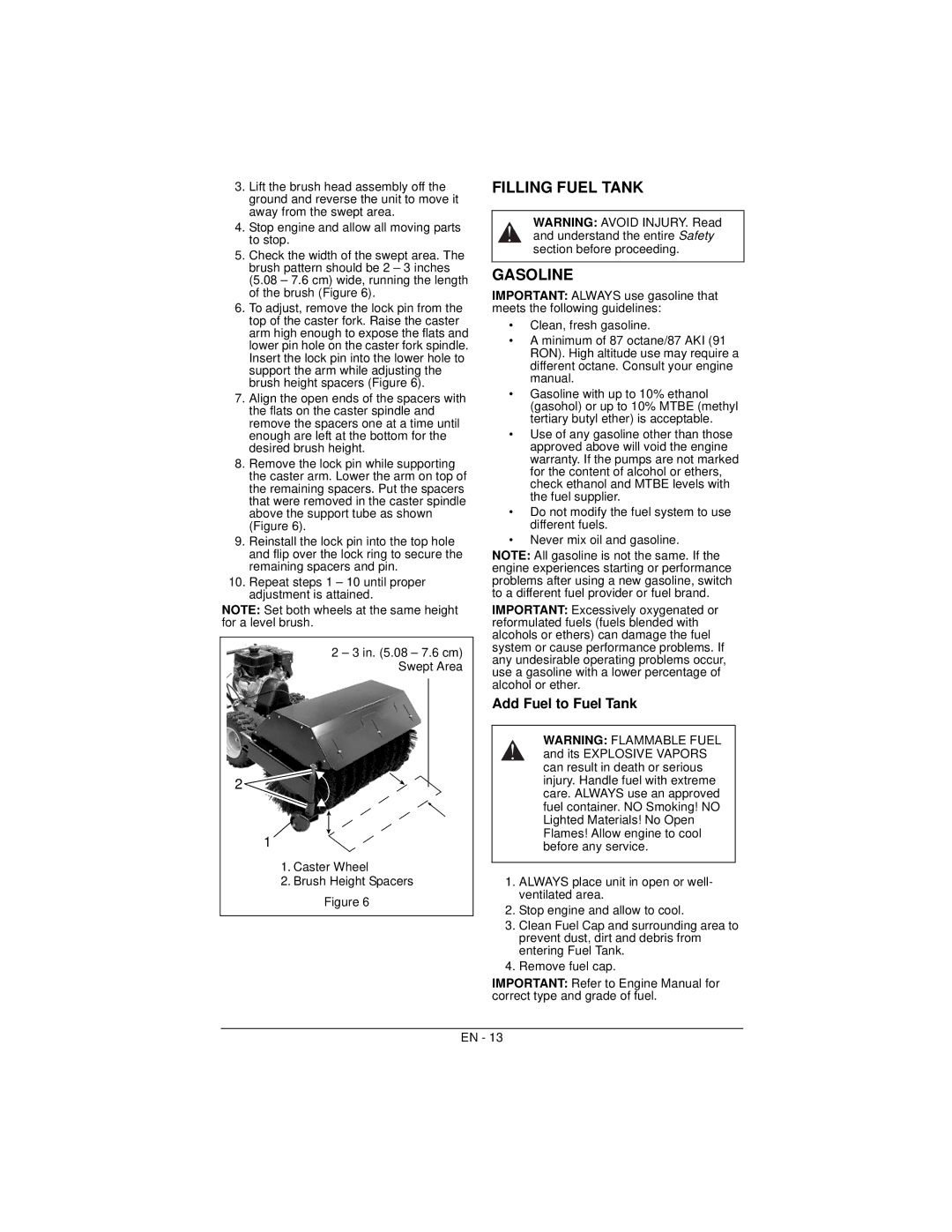
3.Lift the brush head assembly off the ground and reverse the unit to move it away from the swept area.
4.Stop engine and allow all moving parts to stop.
5.Check the width of the swept area. The brush pattern should be 2 – 3 inches (5.08 – 7.6 cm) wide, running the length of the brush (Figure 6).
6.To adjust, remove the lock pin from the top of the caster fork. Raise the caster arm high enough to expose the flats and lower pin hole on the caster fork spindle. Insert the lock pin into the lower hole to support the arm while adjusting the brush height spacers (Figure 6).
7.Align the open ends of the spacers with the flats on the caster spindle and remove the spacers one at a time until enough are left at the bottom for the desired brush height.
8.Remove the lock pin while supporting the caster arm. Lower the arm on top of the remaining spacers. Put the spacers that were removed in the caster spindle above the support tube as shown (Figure 6).
9.Reinstall the lock pin into the top hole and flip over the lock ring to secure the remaining spacers and pin.
10.Repeat steps 1 – 10 until proper adjustment is attained.
NOTE: Set both wheels at the same height for a level brush.
2 – 3 in. (5.08 – 7.6 cm) Swept Area
2![]()
![]()
1
1.Caster Wheel
2.Brush Height Spacers
Figure 6
FILLING FUEL TANK
WARNING: AVOID INJURY. Read and understand the entire Safety section before proceeding.
GASOLINE
IMPORTANT: ALWAYS use gasoline that meets the following guidelines:
•Clean, fresh gasoline.
•A minimum of 87 octane/87 AKI (91 RON). High altitude use may require a different octane. Consult your engine manual.
•Gasoline with up to 10% ethanol (gasohol) or up to 10% MTBE (methyl tertiary butyl ether) is acceptable.
•Use of any gasoline other than those approved above will void the engine warranty. If the pumps are not marked for the content of alcohol or ethers, check ethanol and MTBE levels with the fuel supplier.
•Do not modify the fuel system to use different fuels.
•Never mix oil and gasoline.
NOTE: All gasoline is not the same. If the engine experiences starting or performance problems after using a new gasoline, switch to a different fuel provider or fuel brand.
IMPORTANT: Excessively oxygenated or reformulated fuels (fuels blended with alcohols or ethers) can damage the fuel system or cause performance problems. If any undesirable operating problems occur, use a gasoline with a lower percentage of alcohol or ether.
Add Fuel to Fuel Tank
WARNING: FLAMMABLE FUEL and its EXPLOSIVE VAPORS can result in death or serious injury. Handle fuel with extreme care. ALWAYS use an approved fuel container. NO Smoking! NO Lighted Materials! No Open Flames! Allow engine to cool before any service.
1.ALWAYS place unit in open or well- ventilated area.
2.Stop engine and allow to cool.
3.Clean Fuel Cap and surrounding area to prevent dust, dirt and debris from entering Fuel Tank.
4.Remove fuel cap.
IMPORTANT: Refer to Engine Manual for correct type and grade of fuel.
EN - 13
